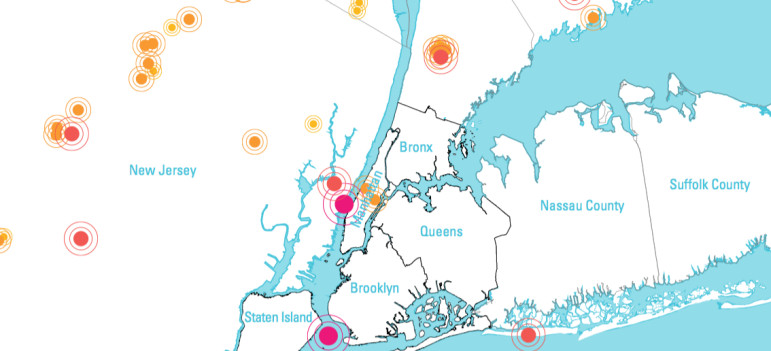
OEM
Historical earthquakes, New York City area, 1737-2014
When I was 12 I experienced a moderate earthquake and aftershock when visiting San Francisco. It was a valuable experience for a New England boy. Feeling everything that exists shake for no visible reason, sensing your high-rise hotel sway and not being able to do anything about it gives one a sense of perspective. You can’t swim or run from plate tectonics.
But according to New York City’s Office of Emergency Management (OEM), there are steps one can take to improve the odds of surviving an earthquake. Given the rarity of earthquakes in the northeast—and the prevalence of outdated disaster advice, like the old saw about opening windows during a tornado, in our collective memory—the tragedy in Nepal is an excuse to review what New Yorkers are supposed to do when the ground starts shaking.
First and foremost, are you supposed to run outside? OEM’s earthquake do’s and don’ts suggest that if you’re out of doors you should stay there and get to as clear an area as you can quickly find. If in your car, OEM says, stay there. If you’re inside a building, don’t rush for the exists. Instead, “drop, cover and hold on” is the rule of thumb: Get on the ground, under something solid and stay there until the shaking stops.
OEM notes that earthquake survival is nearly as dependent on what you do before and after the quake as during the shaking: It recommends working ahead of time to secure top-heavy bookcases and other items to their walls so they don’t fall on you in a seismic event, and watching out for gas leaks and fires after the quake. Only move injured people “if they are in immediate danger,” the office warns.
Obviously, earthquakes aren’t common in the northeast, but according to OEM, “the latest maps, released in July 2014, show that on the East Coast, larger, more damaging earthquakes are possible than previous maps had shown.” (Here’s a live seismograph reporting readings from stations in the New York City area.) What’s more, the unique geology of our area can magnify the effect of seismic shaking: Deep, hard bedrock located adjacent to much softer soil means shock waves get amplified.
The good news, the agency says, is that, “In our metro area buildings must be designed to withstand the Maximum Considered Earthquake: that is, one with a two percent chance of happening at any point within a 50-year period.”
The bad news, per OEM: “Most buildings were built before the City adopted seismic provisions in its Building Code, in 1995.” High-rise buildings tend to be newer and the types of earthquakes we are likely to have here—with short, fast-moving rather than long, slow-moving waves—are less dangerous to high rises. It’s the older, masonry-construction buildings that will be the problem if New York City is ever struck. In a recent “shake table” test, these buildings did not hold up well at all.
Right now, of course, the problems are in Nepal. The New York Times published this handy guide on how to help.









One thought on “UrbaNerd: What Should New Yorkers do in an Earthquake?”
Run like hell………….